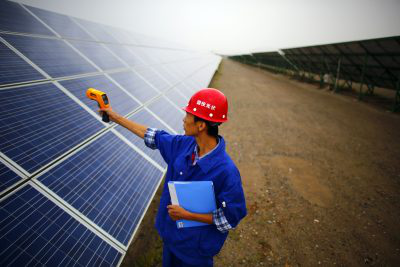时间:2018-09-26
Author: ZhongXiang Zhang, Tianjin University
Widespread use of renewable energy is a real solution for China's energy supply problems. Increasing the share of renewable energy in the total energy supply not only enhances energy security but is also good for the environment and health. China has set targets for alternative energy sources to meet 15 per cent of its energy requirements by 2020 and for the share of non-fossil fuel use to be 20 per cent by 2030.

The Chinese government initially supported solar energy through ‘golden sun’ investment subsidies. After years of simply taking advantage of overseas orders to drive down the cost of manufacturing solar panels, feed-in tariffs for solar power were enacted in July 2011 to create China's own solar power market.
Wind power had benefitted from bidding-based tariffs since 2003. With a total installed capacity of 5.9 gigawatts (GW) at the end of 2007, China had already surpassed its goal to achieve 5 GW by 2010 and met its 2020 target of 30 GW of wind power 10 years ahead of schedule.
Both power demand and installed wind power capacity are increasing faster than planned. Due to the further deterioration of the environment, and combined with the pressure on China to be more ambitious in combatting climate change, China has raised its wind power target to 210 GW of wind power capacity by 2020. This revised target is 180 GW more than the 30 GW target set in September 2007 and three times the United Kingdom's entire current power capacity.
In August 2009, the supportive policy for wind power was replaced with feed-in tariffs. Under this policy, four wind energy areas were designated based on the quality of their wind energy resources and the conditions that they provide for project engineering and construction. On-grid tariffs were set accordingly as benchmarks for wind power projects. The levels were comparable with the tariffs that the National Development and Reform Commission had approved in the previous several years in most regions and were substantially higher than those set through bidding.
By letting investors know the expected rate of return on their projects through the announcement of on-grid tariffs upfront, the Chinese government aims to encourage the development of high-quality wind energy resources. In the meantime, this system will encourage wind power plants to reduce the costs of investment and operation and increase their economic efficiency, which will promote the healthy development of the wider wind industry in China.
Under China's Renewable Energy Law, registered power generators are granted access to grids, which are required to purchase the full amount of renewable energy generated. Over the past 10 years, the cost of wind power projects has been declining but on-grid tariff benchmarks in each zone remained unchanged until 2015. This induces wind power developers to focus on production costs rather than demand and has led to a huge surplus in installed capacity.
This imbalance is particularly acute in northern and western China where there are richer wind resources and where the installed capacity is concentrated, but where load centres are further away. Consequently, a large amount of generated wind power has to be curtailed due to limited local demand or grid system stability constraints.
Given the significantly scaled-up wind power capacity planned for 2020, China should now place more emphasis on companies ensuring the actual flow of power to the grid than on meeting capacity. China needs to improve its power grids and coordinate the development of wind power with the planning and construction of grids, including smart grids. New transmission lines should be constructed at the same time as wind power farms are built.
The grid transmission capacity and transportation of electricity from western and northern China to the south-east can also be increased by building more ultra-high-voltage transmission lines.
The policies of a feed-in tariff and guaranteed renewable power purchases help the widespread use of renewable power in China. But these favourable policies must be adapted to the new situation of a surplus in capacity and a mismatch between generation locations and the load centre. Alternative policies, such as the coordination of coal-fired power and renewable energy development, distributed renewable power generation, incentives for renewable energy absorbing regions, green priority dispatching and a renewable portfolio standard, must be explored to solve the problem of curtailment and encourage wind power developers to choose locations closer to the load centre.
ZhongXiang Zhang is the Founding Dean and Distinguished University Professor at the Ma Yinchu School of Economics, Tianjin University.
This article is abridged from ZhongXiang Zhang, ‘Energy price reform in China’ in Ross Garnaut, Ligang Song and Cai Fang (eds.), China's 40 Years of Reform and Development: 1978-2018, China Update, ANU Press, 2018.
原文链接:
http://www.eastasiaforum.org/2018/09/21/energising-chinas-renewable-power-tariffs/